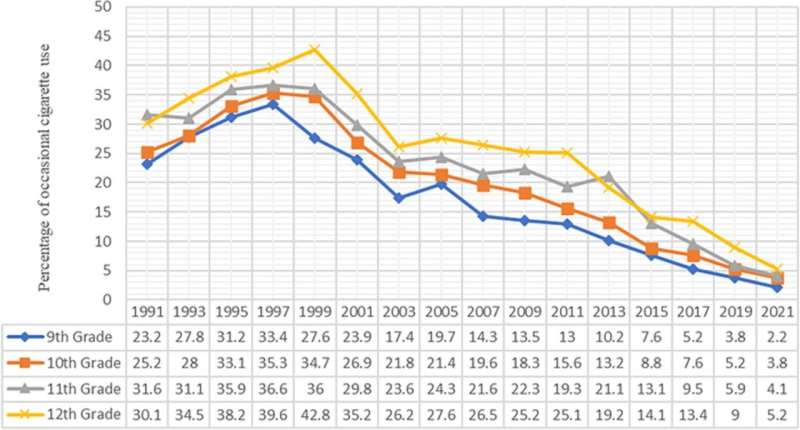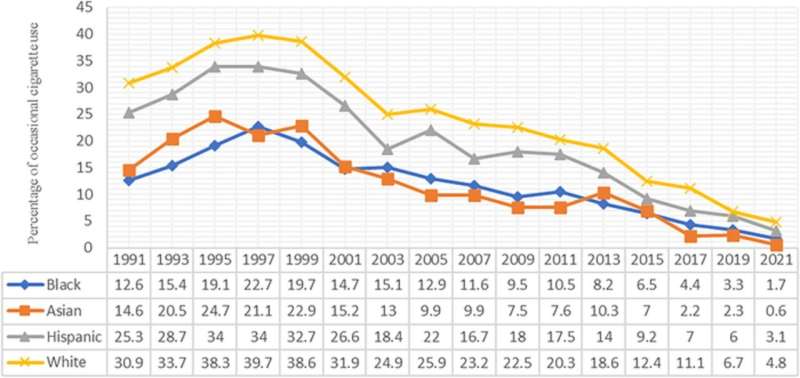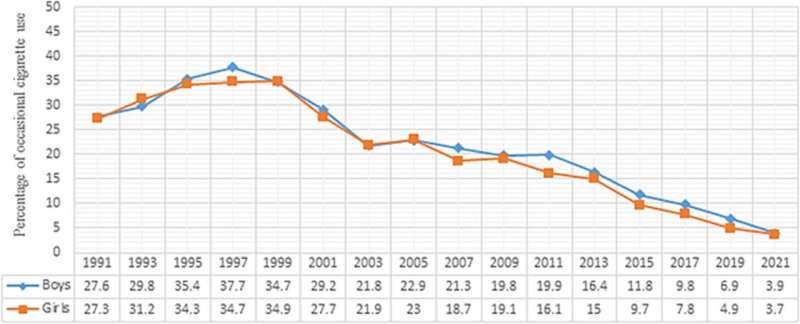This article has been reviewed according to Science X's editorial process and policies. Editors have highlighted the following attributes while ensuring the content's credibility:
fact-checked
trusted source
proofread
Researchers report dramatic decline in cigarette use among US teens over three decades

Cigarette smoking remains the leading avoidable cause of premature death in the United States, accounting for approximately 500,000 deaths or 1 in 5 deaths annually. According to the U.S. Department of Health and Human Services, most adults who smoke cigarettes started before age 18, so preventing cigarette smoking in adolescents is important to reducing smoking in adults.
In a new study, researchers from Florida Atlantic University's Schmidt College of Medicine and collaborators explored overall trends in cigarette smoking among a large sample of U.S. adolescents in grades nine to 12 from 1991 to 2021. They also explored differences by gender as well as race/ethnicity.
Cigarette smoking measures included: ever tried cigarette smoking, which was defined as taking even one or two puffs; currently smoked cigarettes occasionally; currently smoked cigarettes frequently; and currently smoked cigarettes daily.
Results of the study, published in Ochsner Journal online ahead of print, show cigarette smoking in all usage categories (ever, occasional, frequent and daily) significantly decreased from 1991 to 2021.
Among the study findings:
- Ever use cigarettes significantly decreased from 70.1 percent in 1991 to 17.8 percent in 2021, an almost fourfold decline.
- Occasional cigarette use significantly decreased from 27.5 percent in 1991 to 3.8 percent in 2021, a greater than sevenfold decline.
- Frequent cigarette use significantly decreased from 12.7 percent to 0.7 percent, a greater than eighteenfold decline.
- Daily cigarette use declined from 9.8 percent in 1991 to 0.6 percent in 2021, a greater than sixteenfold decline.
- Interestingly, while all grades experienced a significant decline in cigarette use, 12th graders consistently reported the highest percentage of occasional smokers compared to the other school grades, even in 2021. This finding suggests that while smoking has decreased across all age groups, older adolescents might still be more prone to experimenting with cigarettes than their younger counterparts.

"The substantial decrease in cigarette use among U.S. adolescents spanning three decades is an encouraging public health achievement," said Panagiota "Yiota" Kitsantas, Ph.D., senior author, professor and chair, Department of Population Health and Social Medicine, FAU Schmidt College of Medicine. "This decrease underscores the importance of continued vigilance, research, and intervention to further reduce tobacco use and its associated harms."
Overall, inequalities in cigarette use among adolescents by gender have been present for decades. However, by 2021, discrepancies in smoking cigarettes by gender were diminished.
With respect to race/ethnicity, by 2021, the decreases in cigarette consumption were even more pronounced among Black and Asian adolescents, while the rates among whites and Hispanic/Latino youth remained higher but were still significantly lower than the 1997 rates.
"These results show reassuring trends, but they also suggest residual clinical and public health challenges that will require targeted interventions," said Charles H. Hennekens, M.D., Dr.PH, co-author, First Sir Richard Doll Professor of Medicine and senior academic advisor, FAU Schmidt College of Medicine.

"Quitting smoking significantly reduces risks of cardiovascular disease beginning within a matter of months and reaching the non-smoker status within a few years, even among older adults. However, for lung and other cancers, reductions do not even begin to emerge for years after quitting, and even after 10 years, remain midway between the continuing smoker and lifelong nonsmoker."
"Thus, for reducing cardiovascular disease risks, it's never too late to quit, but to reduce risks of cancer, it's never too early."
More information: Maria C. Mejia et al, Trends in Cigarette Smoking Among United States Adolescents, Ochsner Journal (2023). DOI: 10.31486/toj.23.0113




















